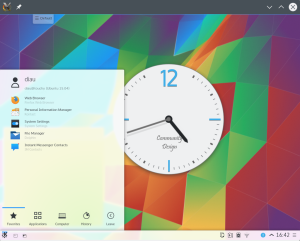Over the last few days I decided to help Martin a bit with the ongoing effort on Wayland, since there are still many parts of work missing in order to have a full Plasma Wayland session to just work, but it’s impressive how fast it’s getting there.
It was just a tiny part but is worth sharing it as it brings pretty pictures! (and shows how easy is to contribute).
The popups of the plasma shell need custom positioning code as normal applications can’t position themselves anymore for security reasons, plus KWin uses its effects framework to do a couple of things on plasma panels and popups:
- Shadows: the shadows are rendered by KWin, they aren’t really a part of the window, as the shadow must not count anything in the position and resizing phase, but just a visual effect on it, it’s also more semantically correct.
- Background effects: both the panel and the popups have a blurred background plus a contrast/saturation effect, to make it more readable and prettier.
After hooking a protocol to control such effects into wayland, here’s the result, almost undistinguishable (there is still a pretty visible graphical issue, points for finding it) from your current X11 Plasma 5.4 session:

So, what needed to be done?
- KWayland protocols: each KWin effect that can now be controlled with X properties need its own wayland protocol extension in order to achieve the same thing, I wrote one for blur behind and background contrast (shadow was already there). The good news here is that Martin is working on a tool to auto generate the binding code from the XML specification of the protocol.
- KWayland-integration repo: The effects that had KWndowSystem API to control them, need a Wayland implementation as well, this goes in the KWindowSystem wayland plugin contained in the kwayland-integration.git repo.
- Modify the KWin effect: then the kwin effect needs to read the data that the client wrote on the surface with the new kwayland protocol and control the effect, in a way that is behaviorally identical to the X11 way, that came from reading X properties from the window
As an “user” of the infrastructure, I’m very impressed about the work that went in the Wayland port of KWin and from the KWayland framework: it really makes using a very challenging and “peculiar” plain C API very easy and elegant in a way familiar with our cozy C++/Qt world.
I can say that is a learning curve soft enough for everyone to jump in and help the big scary transition if they feel to.





